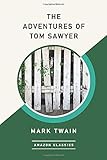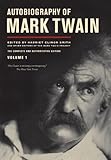Blog – Posted on Wednesday, Mar 20
14 Mark Twain Books That Everyone Should Read

Controversial, brilliant, and ever witty, the man who would shape American literature was born Samuel Langhorne Clemens in a small riverside town in Missouri in 1835. More than a century later, Mark Twain remains one of the best writers that America has ever produced. As an illustrious novelist, distinguished essayist, popular travel writer, beloved humorist, and astute literary critic, Twain casts an intimidatingly long shadow on any American author who dares to follow him. Not to mention, he was ridiculously prolific — writing 28 books and upwards of some 100 short stories!
So rest assured: there’s more to Twain that simply The Adventures of Huckleberry Finn. If you’d like to discover the rich oeuvre of the man who became one of the greatest figures in American literature, here are 14 of the best Mark Twain books — ordered by date of publication, as a few of his works were published posthumously.
If you're feeling overwhelmed by the number of great classics out there, you can also take our 30-second quiz below to narrow it down quickly and get a personalized book recommendation 😉
📚
Which book should you read next?
Discover the perfect book for you. Takes 30 seconds!

1. The Celebrated Jumping Frog of Calaveras County (1865)
The piece that first catapulted Twain into the national eye is, in truth, not so much a book as a short story. Originally published as “Jim Smiley and His Jumping Frog,” “The Celebrated Jumping Frog of Calaveras County” is the tale of a man who gets dragged into an (admittedly one-sided) conversation with another man who simply loves hearing the sound of his own voice. His companion’s stories are pointless and endless, and our poor narrator can barely interject a word to excuse himself. Eventually, the indefatigable storyteller lands on a yarn about a jumping frog — hence the title of the piece. Short as it may be, this piece should be enough to give you a taste of Twain’s inimitable brand of humor, which is a staple in his later works.

2. The Innocents Abroad (1869)
Growing up, Twain was big on travel and took many opportunities to gallivant around the world: a passion that shows up in spades in this early work. As the bestselling book of Twain’s lifetime (and one of the most popular travelogues ever published), The Innocents Abroad documents Twain’s voyages in Europe and the Middle East in hilarious fashion. Trips to the Leaning Tower of Pisa, the Vatican, and even the Sphinx in Egypt create comic set pieces, even while Twain delights in pointing out many a politically incorrect cultural peculiarity in every country.
Though The Innocents Abroad is categorized as nonfiction, the reality is that it lies somewhere between fact and fiction. Some of his accounts may seem somewhat fanciful (which is understandable, seeing as Twain is an author at heart), but the stories are so great that it doesn’t really matter what’s true and what’s not. And if it’s true that “it’s all about the journey,” as they say, then you can’t do better than this terrifically energetic book. For it’s also where you can witness a young Mark Twain at the start of his own long road — wry and irreverent, growing as a writer, and not yet embittered by society.
Looking for something new to read?
Trust real people, not robots, to give you book recommendations.
Or sign up with an email address

3. Roughing It (1872)
When he was only 26 years old, Samuel Clemens lit out to California to mine for gold: this became the basis for Roughing It, or the prequel to The Innocents Abroad and a semi-autobiographical memoir about Twain’s experiences in the American west. Herein lies a potpourri of Twain’s earliest adventures — “semi-autobiographical,” again, as he undoubtedly embellished quite a few of the tall tales that regale its pages. Yet while Roughing It might (aptly) seem a bit rough around the edges, especially when compared to his subsequent works, it’s where Twain really began to hone his art. Many of his later hallmarks are evident here, from his witty observations about otherwise trivial moments to the presence of a galloping, entertaining plot. In short, if you put a young Mark Twain together with a bunch of gold miners and drop them in the middle of the Wild West in the 1860s, this is exactly what you’d expect.

4. The Gilded Age (1873)
Published in 1873 and co-written with Charles Dudley Warner based on a bet with their wives, The Gilded Age was Twain’s first novel. You probably already recognize that the Gilded Age refers to the three decades that followed the Civil War, but what you might not know is that this is the book that coined the term. True to Twain’s Midwestern roots, it’s a splendid satire of the politics and corruption that ran rampant in Washington D.C. in the post-war years — featuring an ensemble cast of crooked politicians, gaudy plutocrats, pretentious bankers, and naïve bystanders, all of whom Twain cheerfully skewers with colorful prose in this book.
If you’d prefer to read only Twain and not Warner, keep your perusal to the first eleven chapters. Amid the get-rich ploys and corporate fraud, they sparkle with Twain’s trademark wit on a subject that’s still pertinent, perhaps more than ever, today. (Twain once wrote: “Reader, suppose you were an idiot. And suppose you were a member of Congress. But I repeat myself.”) Above all, The Gilded Age is a broad, ambitious effort to capture an entire period of time — one that ended up defining it in the English vernacular.

5. The Adventures of Tom Sawyer (1876)
A coming-of-age novel for the ages, this is the story of Tom Sawyer: an aspiring troublemaker, idyllic romantic, devilish orphan, and young dreamer. He carries out his antics under the weary eye of his Aunt Polly, all the while endeavoring to romance Becky Thatcher, the new girl in town and daughter of the local judge. In perhaps the most recognized scene in all of American literature, Tom hoodwinks a bunch of neighborhood boys into whitewashing his aunt’s fence for him. But even a murder and a funeral — his own, by the way — cannot curb his mischief-making.
Though it might be eclipsed these days by The Adventures of Huckleberry Finn, this unrepentantly cracking book is still an American classic. In many ways, The Adventures of Tom Sawyer is even more wry than the former (in part due to the creative license that its third-person point of view affords Twain). Perhaps Twain’s greatest skill was his uncanny ability to tap into the minds of children. Imbued with such exuberance, The Adventures of Tom Sawyer perfectly captures both the innocence and irreverence of youth, seen through the eyes of a boy who embodies boyhood best of all.

6. A Tramp Abroad (1880)
In 1878 and 1879, Twain embarked on a second 15-month trip through Central Europe and the Alps. This is the account of that journey — Twain’s sequel to The Innocents Abroad. (As discerning readers might be able to tell, Twain was once an innocent, now a tramp.) However, he is one of the most endearing tramps in this uproariously epic book, which serves up an entertaining travelogue and social critique of the world all in one. And, in case you’re wondering, no German, Swiss, American, or English person is spared from his sardonic eye. As it comes in Twain’s later years, A Tramp Abroad is a bit more introspective than his past two travel books. But it is still a triumph in the realm of travel writing, and a formative piece of commentary in its own right.

7. The Adventures of Huckleberry Finn (1885)
For a book that needs no introduction, many people rush to regard it. Ernest Hemingway said that American fiction begins and ends with The Adventures of Huckleberry Finn. Most critics call it the Great American Novel. So, though you probably already know the gist of the story, let’s go through it once more for old time’s sake! Huckleberry Finn, a thirteen-year-old boy, is kidnapped from town by the local drunkard — his own father. He ends up escaping with a runaway slave, Jim. As the odd pair drifts southward along the great Mississippi River on a rickety raft, they encounter (and become embroiled in) episodic comic hijinks, from con men and fake deaths to a raging family feud (nineteenth-century style).
Considered by many to be the apex of Twain’s genius, The Adventures of Huckleberry Finn has continued to sweep readers up in its rollicking ride for more than a century. Part of its timeless pull lies in Twain’s protagonists: as a runaway slave and the penniless son of the town drunk, Jim and Huck are, if not at the bottom rung of the social ladder, certainly near it. Their struggle to defy society results in a gloriously rich narrative of boyhood adventure. But beneath the ripping yarn lies a deeply subversive study of racism, morality, and humanity — and it’s this masterful sum of the parts that elevates Huckleberry Finn into the annals of literature as one of the greatest books of all time.

8. A Connecticut Yankee in King Arthur's Court (1889)
The seed of the idea for this book came to Twain while reading Sir Thomas Malory's Le Morte d’Arthur. He reportedly scribbled down: “Dreamt of being a knight errant in armor in the middle ages. Have the notions & habits of thought of the present day mixed with the necessities of that. No pockets in the armor. No way to manage certain requirements of nature. Can't scratch. Cold in the head — can't blow — can't get a handkerchief, can't use iron sleeve.”
Thus the story of Hank Morgan, a mere engineer from Connecticut who is transported back to 528 AD during the reign of King Arthur, was born. As Morgan ingratiates himself as a powerful magician by King Arthur’s side, shenanigans expectedly run riot. But beyond its veneer as a fun “time travel” book, A Connecticut Yankee in King Arthur’s Court is a reality-check for us: a cautionary occasion for Twain to express a deep criticism of our ability to romanticize the past.

9. Pudd'nhead Wilson (1889)
Serialized in The Century Magazine before its publication as a novel in 1894, Pudd’nhead Wilson is the tale of two young boys: one born to a slave woman, and the other, the master’s son. Switched at infancy, their stories inevitably collide and may or may not culminate in a dramatic courtroom showdown. Through it all, Twain skillfully weaves a truly eccentric supporting cast — one that includes David Wilson, a man who finds great joy in collecting fingerprints.
On its surface, Pudd’nhead Wilson might be the book that bears the most similarities to the oeuvre of one of Twain’s contemporaries, Charles Dickens: mistaken identities, rampant crime, a motley crew of characters, and unbridled plot twists abound. However, its entertaining exterior masks the urgent social critique at the heart of the novel. Perhaps even more so than The Adventures of Huckleberry Finn, this is the novel in which Mark Twain most powerfully came out against the institution of slavery — and as an even stronger advocate for emancipation and women’s rights.

10. Personal Recollections of Joan of Arc (1896)
Twain’s swan song in fiction is arguably his finest novel — certainly, he favored it most himself. Though the public slept on Personal Recollections of Joan of Arc when it was first published, and history elevates Huckleberry Finn over top of it, Mark Twain quietly said: “I like Joan of Arc best of all my books; and it is the best; I know it perfectly well. And besides, it furnished me seven times the pleasure afforded me by any of the others.”
Told from the perspective of Sieur Louis de Conte, a fictional companion of Joan’s, this is the story of the famed illiterate French peasant girl who rose to larger-than-legend status in fifteenth-century France. It is not a biography, but an extensively researched novel. Lengthy and rather slow-paced, Personal Recollections of Joan of Arc is notable for its muted humor — a striking departure from the work that Twain can so reliably be expected to produce. But, without his quintessential satire, it becomes something powerful of its own accord: a beautiful, worthy, and serious tribute to a person who embodied all of the virtues that Twain admired in humankind.

11. Following the Equator (1897)
We’re now nearing the end of Twain’s career, which nosedived in the early 1890s. Bankruptcy due to poor investments prompted Twain to embark on a series of international speaking engagements circa 1895: a long trip that enabled him to circumnavigate the far-flung countries of the Victorian British Empire. His many adventures — from diamond mining in South Africa to riding the rails in India — ended up bringing one of his last works of travel writing, Following the Equator, into existence.
Though Twain was considerably older and sadder by this time, this book bears witness to the fact that his keen powers of observation never failed him. So long as there’s no posturing nearby for him to ridicule, Twain could certainly produce a lovely sketch of the country itself! But the virtues of Following the Equator lie (as always) in its lively prose, freewheeling humor, withering irony, and plenty of political incorrectness, reminding you why he was such a beloved icon in his time — and such great company for readers today.

12. The Mysterious Stranger (1916)
In the fittingly titled The Mysterious Stranger, we meet a group of boys who encounter a stranger in late sixteenth-century Austria. He’s turned up in town rather, well, mysteriously. But unfolding circumstances reveal that there’s more to him than meets the eye: he’s an angel, and his name is Satan (not the Satan, by the way. Just a distant relative — explaining the probably inconvenient family name). Unfortunately, this unfinished novel was published posthumously in 1916, so we’ll never know what Twain intended for The Mysterious Stranger in the end. What you will find is an opaque but profound contemplation of human nature itself, as the weight of Twain’s cynicism and disillusionment with humanity ultimately dwarfs the carefree antics that characterized his previous works.

13. Letters from the Earth (1962)
Mark Twain never intended Letters from the Earth to be published, saying that it would be a felony to do so — perhaps because of the controversial opinions that he imparted within it. Needless to say, its premise is provocative: the book is made up of a series of letters written by the archangel Satan that comment on humankind and Christianity. (Satan sent them to archangels Gabriel and Michael, hoping to amuse them while he whittled away his time on Earth after another expulsion from heaven.) More than that, this incisive book gave Twain a platform to produce a scathing rebuke of our god-fearing society.
Despite Twain’s misgivings, Letters from the Earth was nevertheless published posthumously in 1962. But he had actually written it circa 1909, during a black period of his life in which his eldest daughter and wife both died. Make no mistake: this is Twain at his most cynical, defiant, intelligent, belligerent, and cutting. Of course, that means that this book is perhaps his funniest. If you don’t have the time to read it all, go straight to “A Cat-Tale,” “The Damned Human Race,” and the titular story, “Letters from the Earth.”

14. Autobiography of Mark Twain (2010)
In his twilight years, Mark Twain sat on his deathbed, a stenographer by his side, and talked. From the mass of these notes emerged this autobiography: a patchwork of memories, anecdotes, tall tales, and personal philosophies. By this time, Twain had lived through the gold rush, the American promise of manifest destiny, the Civil War, the hopeful dawn of Reconstruction and its eventual collapse, the onset of the American Indian Wars, bankruptcy, adventures around the globe too many to count — all testimony to a life loved well.
Unlike his other works that were published posthumously, it was Twain’s express wish to "publish all of this but not until I am dead.” (Indeed, he indicated that he wanted a century to pass before its publication — probably because he was aware that some of his personal observations would have offended a few generations of people.) Of course, this autobiography is quite original as far as autobiographies go: it forgoes chronology entirely, as Twain simply ended up dictating whatever happened to enter his mind at the time. Yet it brims with all of his characteristic verve and genius, and many of its stories are gems. Most of all, it speaks of a writer of exceptional spirit and a man of exceptional character.
At a time when America was changing so dramatically, expanding westward and still defining itself as a young country, Twain rose to become one of its most enduring voices. He was sometimes serious; sometimes tongue-in-cheek; sometimes tempestuous; always generous, witty, wise, honest, and deeply compassionate. He was larger in life in his time, and there has been no such equivalent since he died. As Twain writes himself in this autobiography, "When I was younger I could remember anything, whether it had happened or not; but my faculties are decaying now and soon I shall be so I cannot remember any but the things that never happened. It is sad to go to pieces like this but we all have to do it.” But what, you may venture to say, a truly extraordinary way to have gone.
***
For more social satire, check out our guide to the 12 best Kurt Vonnegut books packed with humor and bleak reflections on the human condition. If literary classics are what you're after, head to our post on the 15 best John Steinbeck books instead.



